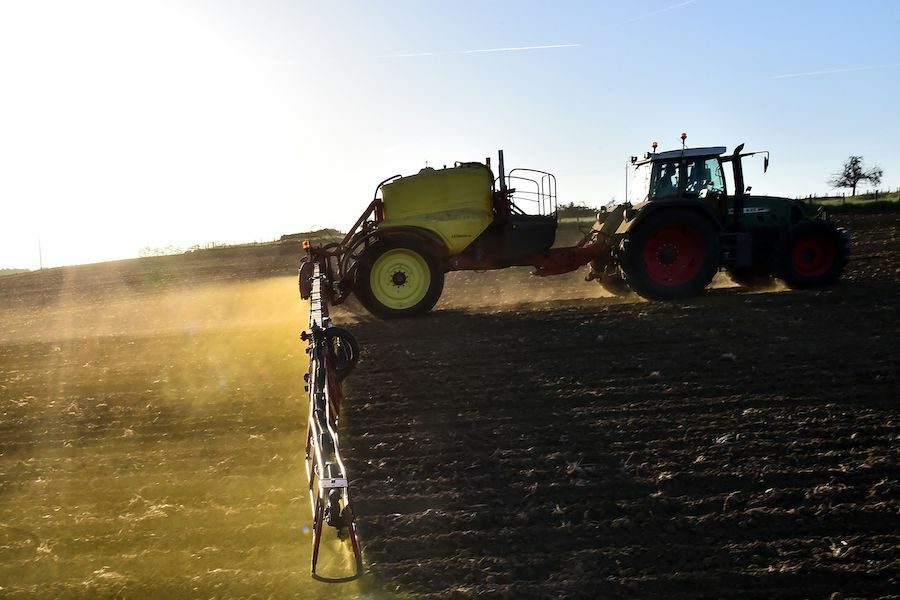Bayer Engineered a New Corn Seed That’s Resistant to Five Herbicides. But How Long Will It Work?
Johnathan Hettinger

Editor’s Note: This story was originally published by the Midwest Center for Investigative Reporting.
A new genetically engineered corn seed designed by Bayer to be sprayed by up to five herbicides could represent the future of farming, providing growers with more pesticides to combat the problem of weed resistance.
But for how long? That’s the question raised by weed scientists, who say farmers need to start switching to non-chemical options to keep weeds under control.
Over the past 50 years, weed resistance has become a significant problem for agriculture in the U.S., with more than 165 unique species of weeds becoming resistant to chemicals. The problem has increased significantly since the introduction of genetically modified crops and use of accompanying herbicides in the 1990s.
The new seed, which Bayer has petitioned the U.S. Department of Agriculture for approval, could be sprayed by glyphosate, glufosinate, dicamba, 2,4-D and quizalofop, giving farmers multiple options for weed control.
Bayer spokeswoman Susan Luke said in an email that, pending regulatory approvals, the company plans a full commercial launch of the seed later this decade.
“We expect HT4 to be widely used – and growers continue to ask for additional crop protection tools to help manage tough-to-control weeds. This product will offer growers more options to manage broadleaf weeds in corn and will provide growers increased flexibility and another tool in the crop protection toolbox,” Luke said.
Corn is the most bountiful crop grown in the United States, making up about 92 million acres of farmland, an area about the size of Minnesota or Michigan; about a third of the crop is used for animal feed, about a third is used for ethanol and the rest is split between human food, beverages, industrial uses and exports. About 90 percent of corn grown in the U.S. is genetically modified, according to the USDA.
The product comes at a time when Bayer, which acquired agribusiness giant Monsanto in 2018, and its pesticides are under scrutiny.
In June, Bayer announced a $10 billion settlement of claims that glyphosate, the active ingredient in Roundup, causes cancer. The company also announced a $400 million settlement of claims that dicamba, a herbicide sold by Bayer and German agribusiness company BASF, has drifted and harmed thousands of other farmers.
By purchasing Monsanto, Bayer acquired some of the most popular cropping systems in the U.S.
Monsanto’s Roundup Ready crops, engineered to be resistant to the herbicide Roundup, quickly became ubiquitous after being introduced in the 1990s. Glyphosate, the active ingredient, is the most commonly used herbicide in the U.S., but as the amount sprayed in crops increased 40-fold between 1992 and 2016, the number of weeds resistant to glyphosate grew. Over the past 25 years, the number of weeds resistant to glyphosate has increased from zero to more than 45, according to the International Survey of Herbicide Resistant Weeds.
In response, agribusiness companies have released crops engineered to be resistant to other herbicides: Monsanto launched its Roundup Ready II crops, engineered to be resistant to glyphosate and dicamba; BASF launched its Liberty crops, designed to be resistant to glyphosate and glufosinate; Corteva Agriscience, formerly DowDupont, released Enlist crops, designed to be resistant to glyphosate, 2,4-D and quizalofop.
The new Bayer technology combines all of these technologies into one. The new product is not designed to be sprayed by all five weed killers at once, but instead to help streamline the current agricultural system, allowing seed dealers to carry one seed that gives farmers a choice on which combination of weed killers they want to spray.
“It’s not a big revolution. It’s the way things are moving,” said Robert Hartlzer, a weed science professor at Iowa State University.
This phenomenon is often called “the pesticide treadmill” — as more weeds develop resistance to more herbicides, new and better herbicides are needed.
The acceleration seems to be getting faster and faster, said Kristin Schafer, executive director of the Pesticide Action Network. PAN is organizing citizens to submit comments against the new Bayer technology, saying the cropping system would be more benefited by switching to crop rotations, more biodiversity on the farm and increased soil health.
“This five-trait corn is absolutely the opposite direction of the way we need to be going,” Schafer said.
Some weeds are already starting to show signs of resistance to dicamba, which has increased significantly in use since Monsanto introduced new cotton and soybean seeds resistant to the herbicide beginning in 2015. Dicamba has also caused widespread damage to the environment because it is harder to control.
Hartzler warned that weeds are quickly outpacing technological developments. Weeds have already developed resistance to each of the herbicides included in the technology, though they are still very effective across the United States.
“It’s really going to be a short-term fix, but at this point in time, it’s what fits the current production system best,” Hartlzer said.
Aaron Hager, a weed science professor at the University of Illinois, found in a 2015 study that using multiple herbicides to kill weeds is better at delaying resistance than switching from one herbicide one year to a different the next. Bayer pointed the Midwest Center to that study and said the new seed will help delay resistance.
But Hager said the way that weeds are resistant to herbicides is changing.
Herbicides work by targeting a specific mechanism in a plant and disrupting that mechanism. For the past 30 years, weeds have largely started to develop resistance at the target site, shifting the way they grow and no longer allowing herbicides to bind to the plant.
But increasingly, plants have started to develop metabolic resistance, which is when the plant’s internal mechanisms are able to metabolize herbicides into non-toxic products, making them ineffective. The mechanism is similar to crops that are able to sustain being sprayed by herbicides.
“We’re in another era now,” Hager said. “We’re trying to understand what has changed and allows them to function more like the crop.”
With metabolic resistance, weeds can develop resistance to herbicides that they haven’t been exposed to before, Hartzler said.
Bayer said that these chemicals are needed. Even with best practices, corn can see a 52 percent yield loss without a herbicide being sprayed, according to a study by the Weed Science Society of America. Hager said that farmers won’t stop using chemicals, but they can use them along with other options.
Both Hager and Hartzler said they are recommending farmers increasingly use non-chemical options. Hartzler said places like Australia are starting to use combines that can help destroy weed seeds, so they don’t continue to grow.
“I know that it’s going to change in the relatively near future simply because even the addition of these new herbicide traits is not going to solve the resistance problem,” Hartzler said.
The Midwest Center for Investigative Reporting is a nonprofit, online newsroom offering investigative and enterprise coverage of agribusiness, Big Ag and related issues through data analysis, visualizations, in-depth reports and interactive web tools. Visit us online at www.investigatemidwest.org
Johnathan Hettinger is a journalist based in Central Illinois, where he grew up. A graduate of the University of Illinois, he has worked at the Midwest Center for Investigative Reporting, the Livingston Enterprise and the (Champaign-Urbana) News-Gazette. Contact Johnathan at jhett93@gmail.com and follow him on Twitter @jhett93.







